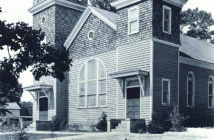A crowd had gathered and was chattering loudly about something, some of the curious were pointing. Children peered cautiously into a deep box. Movement in the box made everyone jump back.
The juvenile copperhead, who had been discovered beside a car tire in an apartment complex on Jefferson Davis Highway, eyed its captors.
Copperheads fit their names; they are copper red in color on their heads, while some may even have a gray tinge on the body depending on locality, and all copperheads have an hourglass pattern on their backs, while the belly and the sides underneath the chin are cream colored.
Also referred to as Mokesen – the Native American Algonquian word meaning “moccasin” and as dumb rattlesnake, red adder, red eye, red snake, white oak snake, deaf snake, beech-leaf snake, chuck head, copper adder, copper-bell, deaf adder, hazel head, popular leaf snake, thunder snake and harlequin snake, the copperhead is well known.
According to the Virginia Herpetological Society, copperheads are between 24 and 36 inches long, with the Virginia record being 48 inches. Adult males are generally larger than females; juveniles have the same color patterns as the adults, except the tip of the tail is sulfur yellow and lacks the black flecking of the adults. As the juveniles mature, the yellow fades from the tails.
But beware: the juvenile snakes are born with venom and can inflict a painful bite just like the adults.
The Virginia Department of Game and Inland Fisheries (VDGIF) says the copperhead snake is found statewide, with the exception of the barrier islands. It occurs at elevations below 3,000 feet in a wide variety of habitats, including wetlands, forests, fields, and edge areas of all types. The copperhead is found in open areas with higher rock densities and uses all types of structures for cover, including abandoned buildings, brush piles, and stone walls.
Mice and other small mammals are the primary prey, but they also take lizards, small snakes, amphibians, small birds, and insects.
Copperheads have natural enemies: hawks, eagles, owls and king snakes eat them.
They mate in April or May and usually one to 17 young are born from mid-August to early October.
The copperhead will often hibernate in the company of other snakes. It is a sluggish snake that relies on camouflage to escape detection. It may vibrate its tail rapidly when alarmed.
Most snakes are harmless and provide a valuable service around your home in the way of pest control (snakes control rodents in the way bats control insects), according to VDGIF. In fact, the presence of snakes around your property or in your house may indicate a rodent problem. There are only three species of venomous snakes in Virginia. The copperhead (found statewide) is the most common – and while it is usually not found inside homes, it may be common in gardens and woodlots. Timber rattlesnakes are common only in the mountainous regions of western Virginia and a small area of extreme southeastern Virginia where they are known as canebrake rattlesnakes; they are a state endangered species. Water moccasins, also commonly referred to as cottonmouths, are found to the south and east of Petersburg and are common only in wet areas.
Venomous snakes eyes are ellipical or cat eye shaped; non-venomous snakes such as the black rat snake, green snake, and corn snake have round eyes. Experts warn residents that it is best to leave snakes alone.
To discourage snakes from moving in on your territory:
- Eliminate habitat near your home. Remove all rock and brush piles and keep grassy areas mowed short near the house. This will eliminate attraction for mice and cover for snakes.
- If a snake is known to have entered the structure, examine the foundation of the house thoroughly. Seal all areas around pipes, vents, or other places that may provide small openings both for rodents and snakes. Also, check the roof for overhanging vegetation. Snakes are good climbers and can also enter through the attic where trees or shrubs provide access.
- Have your house checked for rodent problems. If you can eliminate the food source, the snakes will go elsewhere.

